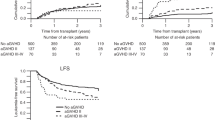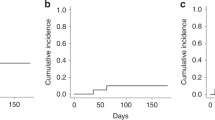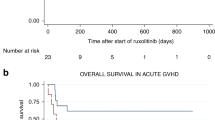Abstract
The management of metastatic renal cell carcinoma (mRCC) remains a therapeutic challenge; less than 10% of patients survive for longer than 5 years. The resistance of renal cancer to chemotherapy may be explained by high levels of the multidrug resistance gene, MDR1. Immune-based treatments for renal cancer have been explored because of their unusual susceptibility to immunological assault. However, response rates to cytokines such as interleukin-2 and interferon-α have ranged from only 10% to 20%, prompting other immunotherapy approaches, such as allogeneic stem-cell transplantation, to be investigated. Several clinical trials have provided evidence of partial or complete disease regression in refractory mRCC following nonmyeloablative stem-cell transplantation. This effect is because of a donor antimalignancy effect mediated by immunocompetent donor T cells, called graft-versus-tumor effect. Unfortunately, less than 30% of patients who could have this procedure will have a human-leukocyte-antigen-compatible sibling, and attention is focusing on alternative donors such as matched unrelated donors and partially mismatched related donors. Despite the improved safety of nonmyeloablative conditioning regimens, transplant-related toxic effects (particularly graft-versus-host disease) remain obstacles to the safe and effective use of this treatment. Regardless of these limitations, innovative approaches have attempted to harness the potential of the graft-versus-tumor effect in mRCC and other solid tumors.
This is a preview of subscription content, access via your institution
Access options
Subscribe to this journal
Receive 12 print issues and online access
$209.00 per year
only $17.42 per issue
Buy this article
- Purchase on Springer Link
- Instant access to full article PDF
Prices may be subject to local taxes which are calculated during checkout
Similar content being viewed by others
References
Cancer Research UK (2004) Statistics. [http://www.cruk.co.uk/aboutcancer/statistics/incidence] (accessed 16 September 2004)
Vogelzang NJ and Stadler WM (1998) Kidney cancer. Lancet 352: 1691–1696
Motzer RJ et al. (1996) Renal cell carcinoma. N Engl J Med 335: 865–875
Kavolius JP et al. (1998) Resection of metastatic renal cell carcinoma. J Clin Oncol 16: 2261–2266
Yagoda A et al. (1995) Chemotherapy for advanced renal-cell carcinoma: 1983–1993. Semin Oncol 22: 42–60
Motzer RJ and Russo P (2000) Systemic therapy for renal cell carcinoma. J Urol 163: 408–417
Hrushesky WJ et al. (1990) Circadian-shaped infusions of floxuridine for progressive metastatic renal cell carcinoma. J Clin Oncol 8: 1504–1513
Yagoda A et al. (1993) Cytotoxic chemotherapy for advanced renal cell carcinoma. Urol Clin North Am 20: 303–321
Fossa SD et al. (1992) Vinblastine in metastatic renal cell carcinoma: EORTC phase II trial 30882. The EORTC Genitourinary Group. Eur J Cancer 28A: 878–880
Milowsky MI and Nanus DM (2003) Chemotherapeutic strategies for renal cell carcinoma. Urol Clin North Am 30: 601–609
Amato RJ (2000) Chemotherapy for renal cell carcinoma. Semin Oncol 27: 177–186
Klein EA (1989) The multidrug resistance gene in renal cell carcinoma. Semin Urol 7: 207–214
Fojo AT et al. (1987) Expression of a multidrug-resistance gene in human tumors and tissues. Proc Natl Acad Sci USA 84: 265–269
Naito S et al. (1993) Expression of P-glycoprotein and multidrug resistance in renal cell carcinoma. Eur Urol 24: 156–160
Volm M et al. (1992) Expression of several resistance mechanisms in untreated human kidney and lung carcinomas. Anticancer Res 12: 1063–1067
Bumpus HC (1928) The apparent disappearance of pulmonary metastasis in a case of hypernephroma following nephrectomy. J Urol 20: 185
Fairlamb DJ (1981) Spontaneous regression of metastases of renal cancer: a report of two cases including the first recorded regression following irradiation of a dominant metastasis and review of the world literature. Cancer 47: 2102–2106
Albini A et al. (2000) Inhibition of angiogenesis and vascular tumor growth by interferon-producing cells: a gene therapy approach. Am J Pathol 156: 1381–1393
Wirth MP (1993) Immunotherapy for metastatic renal cell carcinoma. Urol Clin North Am 20: 283–295
Minasian LM et al. (1993) Interferon alfa-2a in advanced renal cell carcinoma: treatment results and survival in 159 patients with long-term follow-up. J Clin Oncol 11: 1368–1375
Neidhart JA et al. (1991) Vinblastine fails to improve response of renal cancer to interferon alfa-n1: high response rate in patients with pulmonary metastases. J Clin Oncol 9: 832–836
Rosenberg SA et al. (1994) Treatment of 283 consecutive patients with metastatic melanoma or renal cell cancer using high-dose bolus interleukin 2. JAMA 271: 907–913
Negrier S et al. (1998) Recombinant human interleukin-2, recombinant human interferon alfa-2a, or both in metastatic renal-cell carcinoma. Groupe Francais d'Immunotherapie. N Engl J Med 338: 1272–1278
Rosenberg SA (2001) Progress in human tumour immunology and immunotherapy. Nature 411: 380–384
Weiden PL et al. (1981) Antileukemic effect of chronic graft-versus-host disease: contribution to improved survival after allogeneic marrow transplantation. N Engl J Med 304: 1529–1533
Gale RP and Champlin RE (1984) How does bone marrow transplantation cure leukaemia? Lancet 2: 28–30
Kolb HJ et al. (1990) Donor leukocyte transfusions for treatment of recurrent chronic myelogenous leukaemia in marrow transplant patients. Blood 76: 2462–2465
Kolb HJ et al. (1995) Graft-versus-leukemia effect of donor lymphocyte tranfusions in marrow grafted patients: European Group for Blood and Marrow Transplantation Working Party Chronic Leukemia. Blood 86: 2041–2050
Eibl B et al. (1996) Evidence for a graft-versus-tumor effect in a patient treated with marrow ablative chemotherapy and allogeneic bone marrow transplantation for breast cancer. Blood 88: 1501–1508
Ueno NT et al. (1998) Allogeneic peripheral-blood progenitor-cell transplantation for poor-risk patients with metastatic breast cancer. J Clin Oncol 16: 986–993
Slavin S et al. (1998) Nonmyeloablative stem cell transplantation and cell therapy as alternative to conventional bone marrow transplantation with lethal cytoreduction for the treatment of malignant and non-malignant hematologic diseases. Blood 91: 756–763
Corradini P et al. (2002) Reduced-intensity conditioning followed by allografting of hematopoietic cells can produce clinical and molecular remissions in patients with poor-risk hematologic malignancies. Blood 99: 75–82
Caignard A et al. (1996) In situ demonstration of renal cell carcinoma-specific T-cell clones. Int J Cancer 66: 564–570
Jantzer P and Schendel DJ (1998) Human renal cell carcinoma antigen-specific CTLs: antigen-driven selection and long-term persistence in vivo. Cancer Res 58: 3078–3086
Childs R et al. (2000) Regression of metastatic renal cell carcinoma after non-myeloablative allogeneic peripheral-blood stem cell transplantation. N Engl J Med 343: 750–758
Rini BI et al. (2002) Allogeneic stem-cell transplantation of renal cell cancer after nonmyeloablative chemotherapy: feasibility, engraftment, and clinical results. J Clin Oncol 20: 2017–2024
Pedrazzoli P et al. (2002) Allogeneic blood stem cell transplantation after a reduced-intensity, preparative regimen: a pilot study in patients with refractory malignancies. Cancer 94: 2409–2415
Bregni M et al. (2002) Nonmyeloablative conditioning followed by hematopoietic cell allografting and donor lymphocyte infusions for patients with metastatic renal and breast cancer. Blood 99: 4234–4236
Bregni M et al. (2003) Graft versus tumor effect following reduced intensity allogeneic stem cell transplantation in renal cell cancer: on behalf of the EBMT Solid Tumor Working Party [abstract]. Blood 102: 198
Blaise D et al. (2004) Reduced-intensity preparative regimen and allogeneic stem cell transplantation for advanced solid tumors. Blood 103: 435–441
Drachenberg D and Childs RW (2003) Allogeneic stem cell transplantation as immunotherapy for renal cell carcinoma: from immune enhancement to immune replacement. Urol Clin North Am 30: 611–622
Maloney DG et al. (2002) Non-myeloablative transplantation. Hematology (Am Soc Hematol Educ Program) 392–421
Nimer SD et al. (1994) Selective depletion of CD8+ cells for prevention of graft-versus-host disease after bone marrow transplantation: a randomized controlled trial. Transplantation 57: 82–87
Giralt S et al. (2001) Melphalan and purine analog-containing preparative regimens: reduced-intensity conditioning for patients with hematologic malignancies undergoing allogeneic progenitor cell transplantation. Blood 97: 631–637
Chakraverty R et al. (2002) Limiting transplantation-related mortality following unrelated donor stem cell transplantation by using a nonmyeloablative conditioning regimen. Blood 99: 1071–1078
Nagler A et al. (2001) Low-intensity conditioning is sufficient to ensure engraftment in matched unrelated bone marrow transplantation. Exp Hematol 29 362–370
Bornhauser M et al. (2001) Dose-reduced conditioning and allogeneic hematopoietic stem cell transplantation from unrelated donors in 42 patients. Clin Cancer Res 7: 2254–2262
Hentschke P et al. (2003) Low-intensity conditioning and hematopoietic stem cell transplantation in patients with renal and colon carcinoma. Bone Marrow Transplant 31: 253–261
Sykes M et al. (1999) Mixed lymphohaemopoietic chimerism and graft-versus-lymphoma effects after non-myeloablative therapy and HLA-mismatched bone-marrow transplantation. Lancet 353: 1755–1759
Koh LP et al. (2002) Campath-1H, T cell depleted nonmyeloablative peripheral blood stem cell transplantation from 3-6/6 HLA matched family members [abstract]. Blood 100: 2512
Satoh M et al. (2004) Haploidentical, non-myeloablative stem cell transplantation for advanced renal cell cancer. Lancet Oncol 5: 125–126
Miyakoshi S et al. (2004) Successful engraftment after reduced-intensity umbilical cord blood transplantation for adult patients with advanced hematological diseases. Clin Cancer Res 10: 3586–3592
Author information
Authors and Affiliations
Corresponding author
Ethics declarations
Competing interests
The authors declare no competing financial interests.
Rights and permissions
About this article
Cite this article
Arya, M., Chao, D. & Patel, H. Allogeneic hematopoietic stem-cell transplantation: the next generation of therapy for metastatic renal cell cancer. Nat Rev Clin Oncol 1, 32–38 (2004). https://doi.org/10.1038/ncponc0019
Received:
Accepted:
Issue Date:
DOI: https://doi.org/10.1038/ncponc0019
This article is cited by
-
Aberrant expression of the hematopoietic-restricted minor histocompatibility antigen LRH-1 on solid tumors results in efficient cytotoxic T cell-mediated lysis
Cancer Immunology, Immunotherapy (2009)



